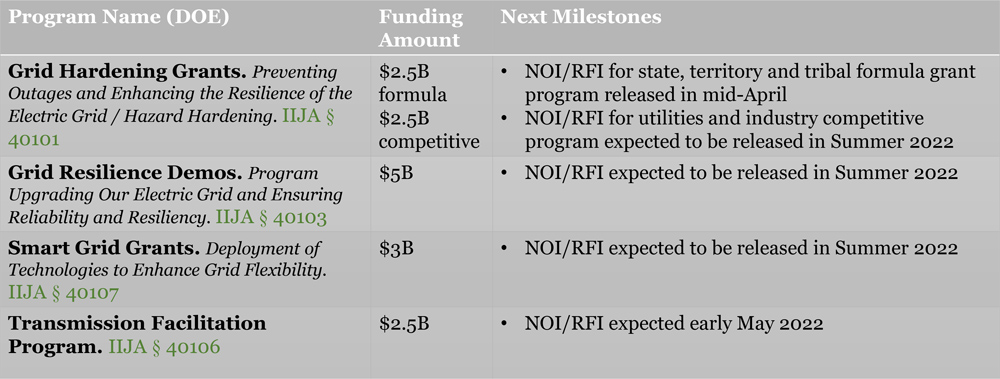WASHINGTON — The Department of Energy asked Tuesday for comment on how it should implement the “anchor tenant” and $2.5 billion revolving loan programs for transmission authorized by the bipartisan Infrastructure Investment and Jobs Act.
DOE’s Transmission Facilitation Program (TFP) is intended to aid the construction of grid infrastructure that improves reliability and resilience or increases interregional transfers. DOE said such expansions also would increase the availability of lower-cost and low-carbon electricity sources, furthering the Biden administration’s goal of a carbon-free electric grid by 2035 and a net zero emissions economy by 2050.
Avi Zevin, DOE’s deputy general counsel for energy policy, announced the notice of intent (NOI) and request for information (RFI) on the TFP at the Energy Bar Association’s annual meeting in D.C. Responses will be due 30 days after publication of the NOI/RFI in the Federal Register.
“It is critical that the infrastructure that we develop with money and authority from the law is used to address climate change by reducing greenhouse gas emissions,” Zevin said. “As the Secretary [Jennifer Granholm] has said many times, the climate crisis is real. Our hair needs to be on fire. [We need] to deploy, deploy, deploy clean energy in order to address it.”
The TFP allows DOE to offer three types of support:
- Capacity Contracts: DOE can purchase up to 50% of the proposed transmission capacity of an eligible transmission line for up to 40 years.
- Loans: DOE may make loans for the costs of carrying out an eligible project — new lines of at least 1,000 MW, (500 MW for projects in an existing transmission corridor) or connections of an isolated microgrid to existing transmission in Alaska, Hawaii or U.S. territories.
- Public-Private Partnerships: DOE can participate in designing, developing, constructing, operating, maintaining or owning an eligible project that is in a national interest electric transmission corridor or necessary to accommodate an actual or projected increase in demand for transmission across more than one state or transmission planning region.
DOE asked for feedback on the application process, criteria for qualification and selection of projects under the TFP.
DOE is authorized to borrow up to $2.5 billion from the Treasury at any one time. The loan receipts and revenue from capacity contracts will be put in a fund to support the TFP.

Zevin said “$2.5 billion, as everyone in this room knows, is not a huge amount of money for large-scale transmission development. So, one of the critical items that we are thinking about, and we would love your input on, is mechanisms that we can use to leverage that money to drive additional deployment from the private sector.”
Funding applications will be accepted after DOE issues an initial solicitation for proposals. If DOE approves a capacity contract, it expects to issue its first solicitation in 2022 and a second in early 2023.
The first solicitation will be limited to projects that would begin commercial operation by the end of 2027. In the second solicitation, DOE will consider all forms of support under the TFP.
DOE will require applicants to show that the eligible project is unlikely to be constructed as quickly or with as much capacity without the department’s help. Applicants also must show that the project has a realistic chance of being constructed and going into commercial operation.
DOE is seeking specific feedback on whether it should conduct separate solicitations or request applications under a single solicitation that remains open for a rolling review and determination.
It also requested feedback on how it should consider the impact of proposed projects on reliability and resilience and reducing GHGs or generating host community benefits.
 David Getts, SouthWestern Power Group | © RTO Insider LLC
David Getts, SouthWestern Power Group | © RTO Insider LLCDavid Getts, general manager of SouthWestern Power Group, told the EBA conference the TFP is “potentially quite helpful” to transmission developers although too late to help his company’s efforts on the SunZia transmission project to deliver New Mexico wind power to the Palo Verde hub in Arizona.
“I think the single most beneficial aspect of the TFP will be the capacity contract, or the ability of DOE to enter into an anchor tenant relationship,” Getts said. “That potentially is a game changer” addressing the “chicken-egg” difficulty of signing customers to a line before it is built.
“You can’t find a customer — i.e., a private sector company that wants to use your line or [buy] energy from the generation project that depends on your line — until you have all your permits,” he said. “People say you’re not real; you’re never gonna happen.”
Getts had some questions of his own. “If DoD is an anchor tenant, that’s great, but you’ve got to have another anchor tenant — you might need that to get financed,” he continued. “What’s that interaction like between the anchor tenants? Are they competing for end-use customers? How does the governance work?”


